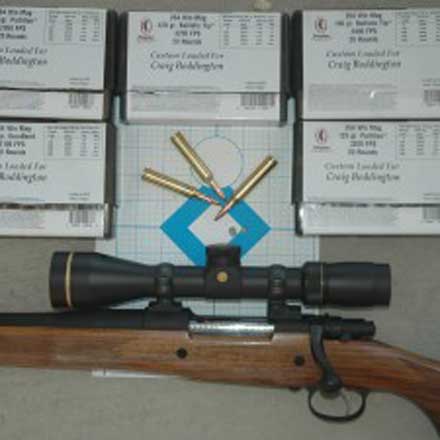
The .264 Winchester Magnum was introduced in 1958 and was Winchester’s second “belted magnum” cartridge based on the .375 H&H case cut down to .30-06 length. The first, the .458 Winchester Magnum, preceded it by two years. The second, the .338 Winchester Magnum, was introduced the same year. The fourth and last of the family, the .300 Winchester Magnum, came along in 1963. Of the four, the .264 Winchester Magnum is now the least known and by far the least popular, barely hovering above obsolescence for some years now.
It was not always so. The .264 was introduced with an unprecedented media blitz, and it took off like a rocket—at least initially. As a concept, the cartridge had advantages, and it also had some problems. In the 1950s, the fast Weatherby magnums were receiving tremendous publicity. This is partly because they were both good and fast, and partly because Roy Weatherby was a marketing genius. No doubt, he made the “majors” a bit nervous; Winchester responded with their Winchester Magnums, and a short while later (in 1962) Remington answered with their 7mm Remington Magnum.
Today, we think of this era of cartridge development as the “magnum craze,” or, technically, because of recent developments, the “first magnum craze.” Any cartridge with a magnum moniker seemed certain to succeed! The .264 was indeed fast, and it had the added advantage of being introduced in what was then America’s favorite bolt action; the Winchester Model 70, the “rifleman’s rifle.” The new .264 was introduced in a 26-inch-barrel variant called “The Westerner.” Sexy and successful.
The new cartridge also had some issues, although some years passed before the word got out. For one thing, it was a bit overbore capacity, meaning the caliber was a bit too small for the size of the case, especially with late 1950s propellants. It really needed an extra-long barrel to burn its prodigious load of powder, and over time we learned that throat erosion was an issue. Too, in those innocent days when few people had access to a chronograph, Winchester threw a bit of blue sky into their published ballistics figures. The .264 was indeed fast and flat-shooting, but never quite as good as the factory said it was. America’s leading gunwriter, Jack O’Connor, was being neither kind nor cutting, just factual, when he described the new .264 as offering no significant improvement over his beloved .270.
The .264 had two...
other problems, one inherent, the other earned. Inherent, although called by its English system bullet diameter, it’s a 6.5mm. Though popular in Europe, the 6.5mm has never had a big following on our side of the pond. You can argue, correctly, that standard 6.5mm bullets are long for caliber and thus penetrate well, hold their velocity well, and do a good job of resisting wind. But, they’re still 6.5s, never big sellers in America. Well Remington needed to do something to counter Winchester’s success with their new magnums. Their first answer was the 7mm Remington Magnum. Because of its heavier bullets, it was more versatile than the .264, and because of its larger bullet diameter (.284-inch), it was less overbore capacity, better able to perform from “standard” 24-inch barrels. It took time, but the 7mm Remington Magnum eventually blew the .264 off the market and went on to become the world’s most successful and most popular belted magnum.
Things took more time in those days, so this lay in the future when I acquired my first .264 in 1965. My rifle was actually an early Remington M700 with a 24-inch barrel, so never mind that I never got even close to the velocity I thought I was getting! I was a child of that first magnum era, and I thought my .264 was a magic wand. Honestly, it worked pretty darned well in my hands, and the game I took with it never missed the (probably) couple hundred extra feet per second I thought I had, but almost certainly never did.
That rifle was stolen in about 1979. The magnum craze had waned, and it had been some time since I actually used it. I sort of understood that I’d bought into hype, and by then I was using mostly a .270 and a .30-06. Good grief, what a revelation. O’Connor and Whelen had been right all along! The .264 was already a rare bird with just a couple of pedestrian factory loads still available and almost no new rifles so chambered.
More time passed, and I still retained a soft spot for the .264. This was mostly nostalgia, but I also understood what a new generation of 1,000-yard shooters had learned; the long-for-caliber 6.5mm bullet was pretty cool. A couple of years ago, I choked it up and followed a long-standing desire to get another .264. I had an in-the-white Parker Ackley left-hand Santa Barbara Mauser action, and I had a good 6.5mm Obermayer barrel. Serengeti Rifles up in Montana put them together for me in a gorgeous laminated-stock .264 with 26-inch...
barrel, sort of my own version of a “westerner.”
There are plenty of 6.5mm component bullets, but not much in the way of new loading data, and even less selection in factory loads. Winchester and Remington both still offer 140-grain loads, and they shoot pretty well in this rifle, but that’s it from themajors. Fortunately, it’s a larger playing field these days. Somebody at Nosler mustreally like the .264, because their custom ammo line offers six loads with six different bullets from 100 to 140 grains. Gathering brass, I tried ‘em all! My rifle happens to like their 130-grain AccuBond, which steps along at a lively 3100 fps in my rifle.

Okay, that’s a bit faster than a .270 Winchester, not as fast as a .270 WSM. But, thegreater sectional density (SD, weight in relation to diameter) offers a slight downrange edge. With its long barrel and fairly heavy laminated stock, recoil is extremely mild,and I’ve had a lot of fun with this rifle. So far, I’ve used it for both whitetail and muledeer, and I took it to Pakistan for Urial sheep and ibex. Performance has been spectacular—just like the .264 of my youth!
Is it really worth the trouble? Probably not. Like I said, Jack O’Connor had it right 50 years ago. We can split all the ballistic hairs we want, but it isn’t enough better than a standard .270 Winchester to be worth all the trouble. If you want more, it isn’t as fast or as flat shooting as the .270 WSM—and of course both of these .270s offer a much wider selection of loads. But, I like my .264 very much. For me, it’s a trip down memorylane, and sometimes it’s fun to use something a bit different.
Over the years, a few cartridges have hovered near extinction and then madecomebacks. There is some renewed interest in the 6.5mm, and this year, Ruger haschambered a run of M77s in .264, the first new .264 rifle in many a year. Even so, I do not predict a major resurgence of interest in the .264 Winchester Magnum. It has languished for too long, and there are too many other much more popular cartridges that do essentially the same things, including its old nemesis, the 7mm Remington Magnum. But, if you...
have one, don’t shelve it, and if you see a good deal on anoriginal with some barrel life left, don’t pass it by. There are plenty of bullets and, if you dig a bit, plenty of good loads. I think you’ll be surprised at how effective this almostforgotten cartridge really can be.